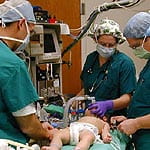How is Anesthesia Used During Cardiac Surgery?
Anesthesia is a medical treatment that prevents patients from feeling pain during surgery.

During the preoperative visit, a member of the anesthesia team will talk with the family and patient about the use of preoperative (before surgery begins) medicines. The decision about giving a medicine before surgery will depend on the age of the child, the type of cardiac defect present, and the anxiety level of the child.
Common Medications
Midazolam
Midazolam is the drug usually given before surgery. In some cases, morphine may be used. Midazolam (or Versed®) is a sedative which can be given to children orally (by mouth), intranasally (in the nose) or intravenously (in a vein).
Midazolam can cause, sleepiness, less anxiety and forgetfulness. After getting this medicine, most children will not remember being taken to the operating room for surgery.
When given through an intravenous (IV) catheter or through the nose (intranasally), midazolam works fast. If it is taken by mouth, it takes 15 to 20 minutes to work. Patients and families can see Midazolam is working when patients get sleepy or tired after taking it.
Children who have low oxygen saturations because of congenital heart defects may be helped by sedation before being put to sleep. The anesthesiologist (a doctor who manages the medicines (anesthesia) before and during surgery and nursing staff will closely monitor the child. They will give additional oxygen if needed.
Midazolam is not given before surgery to children under 6 months of age. It is not helpful to children of this age.
Some children have unusual responses to midazolam. This can be things like talking a lot or, such as excessive or silly talking, laughter, or very rarely more anxiety.
Most children who have increased anxiety have no memory of events after the midazolam has taken effect. Parents should talk with the anesthesia team member about this possibility during the preoperative visit.
Atropine
Infants under 6 months of age and children with Down's syndrome will sometimes get a medication called atropine before anesthesia. Atropine works to produce, dry mouth and increased heart rate.
These effects are helpful before anesthesia because they reduce airway secretions. They also prevent a slow heart rate (bradycardia). Atropine can be given by an intramuscular injection (in the muscle) or through an IV. It may cause some children to be red or flushed.
Morphine
Morphine is a narcotic that produces sedation and analgesia (blocking the sensation of pain). Morphine may be used before surgery for certain types of congenital heart defects.
The most common side effect of morphine (or any narcotic) is itching. The nose and face are the itchiest areas. Other side effects may include small hive-like bumps on the skin near the site at which the drug was given.
Before Surgery
Induction agents are the drugs used to get a child "off to sleep." An anesthetic sleep is not like a normal sleep. During normal sleep a child would awaken if stimulated. This does not happen during an anesthetic sleep if sufficient amounts of anesthetic are given. It is important for your child to understand this.
Many children in the 6- to 12-year-old range are especially concerned about this and need to be reassured that they will be pain-free and totally unaware that they are having an operation. A six-hour operation may seem like only a few minutes to the child under a general anesthetic.
The method and drugs used during the induction of anesthesia depend on a variety of factors including the age of the child and his or her medical condition. The induction of anesthesia will be one of the topics the anesthesia team member will discuss with you the day before surgery.
Inhalation Induction
Most children will not need to have an IV placed before they are asleep. These children can be put to sleep using an "inhalational anesthetic" (gas or “sleepy air”).
A sedated child is able to breathe off to sleep without becoming upset or anxious. All procedures that could cause pain (like starting IVs) are done after the child is sedated.
Children with certain types of heart disease may be able to tolerate an inhalational (gas) induction.
Other Options
If the anesthesia team decides your child is not a good candidate for an inhalation induction, one of two options may be used.
The child may have an IV placed. They will get an intravenous medicine to make them sleepy.
Most cardiac patients need breathing support after surgery because of their heart problems. The use of narcotics in infants with complex heart defects is not problematic.
During Surgery
After the child is completely anesthetized, a plastic tube is put in the trachea or windpipe. This is known as intubation. It allows the anesthesiologist to control the size and rate of breathing.
After intubation, a catheter is placed arterially (usually in a wrist or ankle) to allow continuous measurement of blood pressure and frequent blood sampling.
The anesthesia team member uses the blood test to decide if changes are needed in the ventilator settings. These results also help decide what additional medications need to be given.
In many cases, a central venous catheter is placed. This is a special IV catheter that is placed into one of the large veins which goes directly into the heart. These catheters are helpful for giving strong medications safely. They also help to monitor pressures around the heart.
During the surgery, anesthesia will be maintained with many different medicines. Most children will get doses of a strong narcotic (throughout the surgery. The dose given will depend on a variety of factors.
Everyone is Unique
Each child who comes to the operating room for cardiac surgery has their own cardiac defect and anesthetic needs.
The job of the anesthesia team is to create an anesthetic to give comfort and safety to each child.
Parents, and children can ask about the medications and reasoning behind the use of those medications during their surgery.



